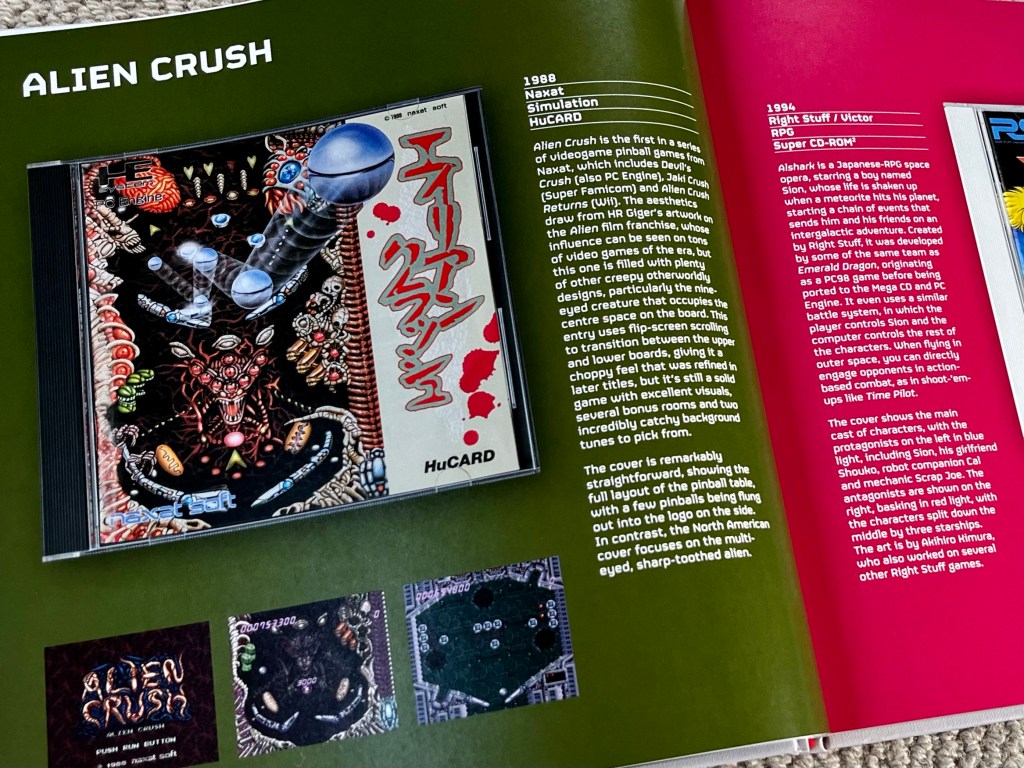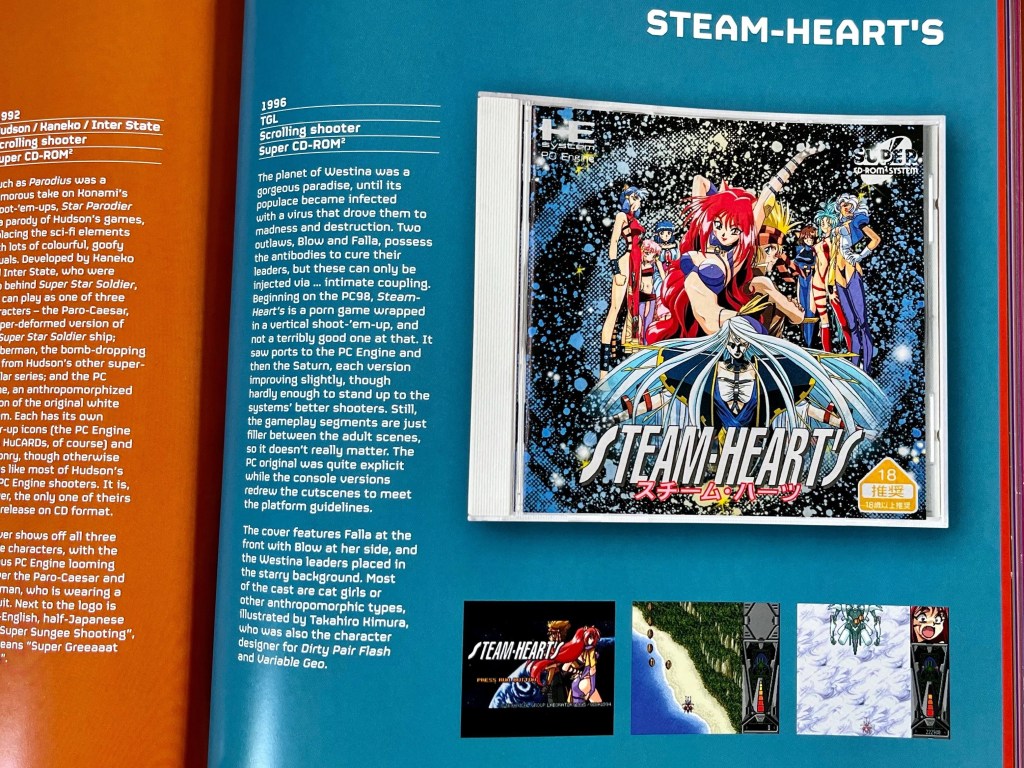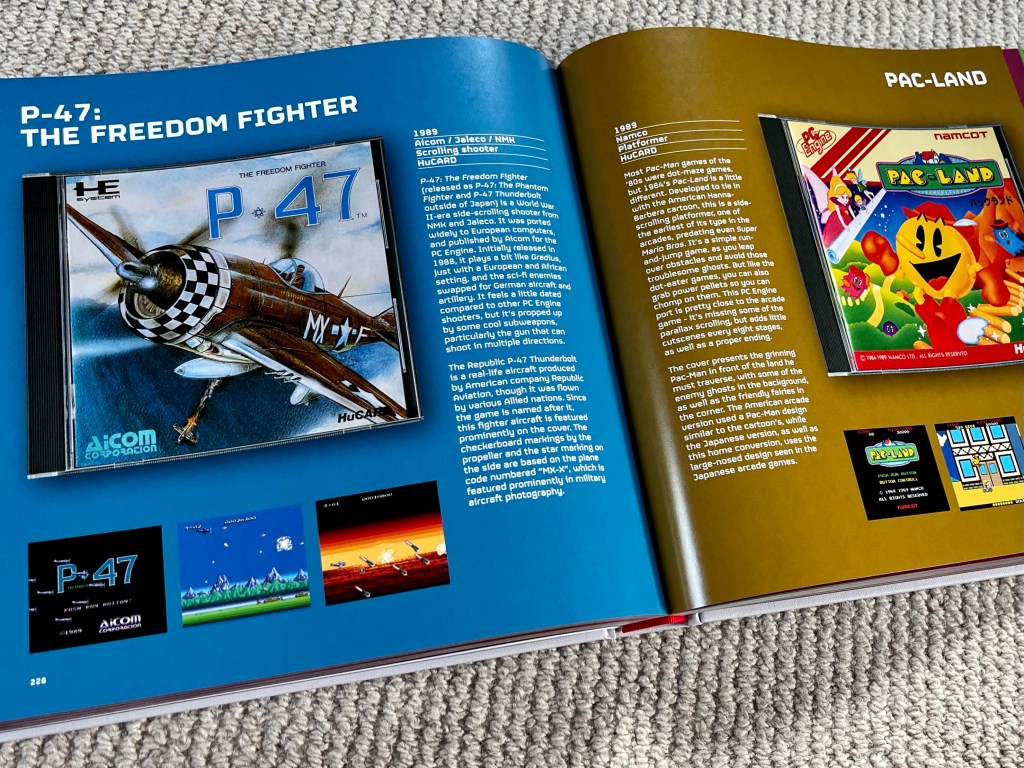There were all kinds of reasons why I wasn’t going to review PC Engine: The Box Art Collection that are mostly related and can be taken in any order because they all circle around each other… 1. I’d already reviewed ZX Nightmares the same week it came out, albeit several days earlier. 2. I’m not a book review site, so two on the trot is pushing my luck. 3. I struggle to get one major feature out per week let alone do two reviews justice. 4. I had other time-sensitive stuff already lined-up which meant delaying it two weeks wasn’t feasible and delaying it more meant it wouldn’t be news anymore. And yet here we still are!

The thing is, more than anything else I do here, I love writing book reviews! And I love this book! And no one is coming to little old me for news anyway. And it’s not like it’s going anywhere so giving my Game of the Year Halfway Hotlist its proper halfway through the year slot isn’t the end of the world… Well, hopefully, although after nasty old Sega forced Bitmap Books to pull The Unofficial MD/Gen: A Visual Compendium book a few months ago, nothing would surprise me anymore! So far so good though, so let me try and further justify why we’re here way after the event… Primarily, it deserves it! Also, despite my self-deprecation, it seems that you, my dear friends who visit my site, quite like these book reviews I occasionally do too – I’m not one for counting stats (outside of my current obsession with Diablo IV!) but they do seem popular, and a couple of them unbelievably so! Finally, since I first laid eyes on the exotic little beast in question here in the late-eighties, it’s been my favourite console I’ve still never owned, so this book is a point of personal fascination too!

Right, I’ve properly talked myself into it now, so here’s the plan. I’m going to follow the same format as I did in what was probably an equally untimely manner for its predecessor, Game Boy: The Box Art Collection, where we have a look at the book overall then jump into some of the games it covers to get a proper taste of it. Obviously, with almost as many bits of box art covered as its 372 pages, I can only pick a handful, so I’ll find a couple of not-so-old favourites of mine from the PC-Engine Mini, then the one that jumps out of these pages at me the most, then something I don’t know at all, and finally something I’ve never played but would like to as a result of reading the book. Two quick bits of housekeeping too… Firstly, whenever I’m given a review copy of something, I always tell you, but in this case I gladly paid the £29.99 asking price; as I said, I’m here because I love doing it! Secondly – and this is a first for me – since 2001 I’ve worked for what was, at the time, NEC Electronics, part of the same NEC behind the PC-Engine, and while it doesn’t really having any bearing on what’s here, I wanted to mention it.

With that, shall we finally talk book? Firstly, I need to tell you this book is a whopper – 2.5kg of whopper, in fact! From the outside, you’ve got a striking red metallic foil logo on the 25x25cm white hardback cover that oozes the quality you’ll find within. As with all Bitmap Books’ publications, its lithographic printing on some top-notch paper, with thread-sewn binding that will keep you reading it like new for years to come, as well as be able to lay this beast open flat. And all that means the all-important box art photography, as well as the screenshots that accompany it, are presented in their best possible light. And while not quite as exciting, you couldn’t ask for more of what it arrives in, with no expense spared making sure it gets to you in perfect condition, from the shrink-wrapping of the book itself to above-and-beyond protective padding and a custom stiff cardboard box. You get a free PDF version too if all that book becomes too much for you! I should point out I’m talking standard edition too – there’s also a limited to two thousand collector’s edition in an exclusively illustrated slipcase and dust jacket.

Before we get on to my taster with a few of the games covered, you’ve got sixteen pages of history, commentary and insights into the machine itself, but some of the most fascinating insights come next in a four page interview with collector and contributor Lee Thacker that would have been with me instead in my dream universe – as said, this is my favourite console I’ve never owned but as a collector of all the Minis we’ve seen for loads of consoles and arcade systems over recent years, my PC Engine Mini is top of the pile in that slightly less impressive reality! For me, my non-history started with a Computer & Video Games magazine feature in May 1988, and I was instantly blown away by this “state of the art games console with a 16-bit processor, dozens of rich, vibrant colours, six channel sound and a dedicated sprite handler that allows huge animated characters to move smoothly around the screen” produced by Japanese electronics giant NEC and launched in Japan at the end of the previous year. As was usually the case back then though, it was the screenshots that sold it to me – that holy grail of arcade perfect at home was finally upon us! Here in the UK it was never really meant to be though, despite its success in Japan and in North America in its TurboGrafx-16 guise, but to me that just added to its mystique. Not to mention cost, which is why I never got one!

Fortunately we ended up with other ways and means, and jumping to our tour through a few of the book’s highlights, I’m going to start with the very first PC Engine game I ever played, Alien Crush from 1988, which is also right near the start as the three hundred or so bits of box art covered here come alphabetically, with their photos dominating the vibrantly coloured pages alongside three screenshots, details of when and where from, a paragraph on the game behind it and another on the box art itself. I’ve loved a pinball game since Pinball Wizard on the VIC-20 (also the very first game I featured here), and while this game’s successors, and not least its far more recent spiritual successor, Demon’s Tilt, might give you more and do so more elegantly, I still can’t resist a go on this multi-screened, Giger-inspired pioneer every time I fire up my Mini; the thing is, there’s no “a go” on this because you always need one more go! I think I’ve picked a game to start with where the book has the least to say about a cover though! It focusses on the PC Engine rather than TurboGrafx versions, but does include both original HuCard and later Super CD games, and for this one it’s incredibly straightforward, with an artistic tart-up of the in-game table and a ball flying into the logo down the right. Nothing wrong with that though, and a hell of a game to start with (although skip a few pages to its sequel, Devil’s Crush, for literal hell)!

I’m going all the way to the other end of the book for my next system favourite to look at, Victory Run, which is a racing game from 1987 that also featured in that C&VG article I was so taken by! One of my favourite pages in the book to look at too, with orange on orange on orange everywhere, including a screenshot captured in-game just before one of my all-time favourite sights in any game, and one of the most dramatic sunsets you’ll ever see as you hit the mountains before leaving France in the Dakar Rally! While it’s a lot like Out Run on the surface, there’s way more depth here, as you pre-select spare parts to bring along to keep your car maintained, albeit in a very accessible way for those who just want the best race action on the system (including the later port of Out Run)! As the book tells us, the cover art itself does a great job of representing the race itself (although it’s not all orange!), with your car starkly intruding upon a scene of dust and desert and blazing sun. It’s a really good example of author Kurt Kalata’s well-researched commentary throughout too, explaining how the finished illustration featured a car that was actually a remnant of the original design rather than the finished product.

I really appreciate the style of commentary too, knowledgeable but friendly and in normal language rather than art critic language! I’d love to know how an art critic would describe our next stop-off though, because this is the piece of box art that jumped out at me the most, and I’m not sure my eyes are ever going to recover! It’s a totally Japanese mass of tumbling Bomberman heads behind a less disembodied and more familiar version of Bomberman, all in front of a huge explosion, and the colours are insane, and it’s so full of character! And I should mention it’s for 1994’s Bomberman: Panic Bomber, which was a spin on the falling block matching puzzler Puyo Puyo and the like, rather than the multiplayer mazey madness of the other Bombermans also covered in the book (as is Puyo Puyo). I’ve never played this one but what I’m being told here is doing a pretty good job of selling me on it, especially as I can see from the screenshots it looks pretty colourblind-friendly too, which is often the demise of many of these for me as much as I enjoy the genre when I can!

While I am familiar with Bomberman, even if not that particular game, something I didn’t know at all before I read the book was Steam-Heart’s. Was a close second for the one that jumped out at me the most though, and if I was looking for a piece of box art to highlight that I’d also hang on my wall, it might well be this one, although I’m not sure the wife would appreciate it so much! She definitely wouldn’t appreciate the game either, which is a “porn game wrapped in a vertical shoot ‘em up” from 1996, which made me laugh! More than anything, I associate the PC Engine with the breadth and quality of its vertical shooters in particular, but the book’s also telling me it’s probably not one to go and seek out, with the gameplay simply acting as filler between adult scenes… Which, in reality, has sold me on it even more than it did Bomberman just now! We’ll come back to another game they’ve properly sold me on in a second, but let me quickly mention the box art, which I just love the style of rather than its content; reminds me of a Star Wars duvet cover I had in the early eighties – the very dawn of the duvet cover! Anyway, what that didn’t feature against its stylistic, starry backdrop was a bunch of cat girls in skimpy bikinis by a bloke called Takahiro Kimura, who was also the character designer for “Dirty Pair Flash” – again, good knowledge by the author!

Right, last stop on our tour, and as just said, it’s the game I’ve never played before but would like to as a result of reading the book. I’ll get to that shortly, but what I enjoyed about this book more than anything else is what I enjoy about this whole retro gaming malarkey more than anything else, and that’s discovery. Yes, we’re talking stuff that’s over three decades old, but you’ll never run out of new old games to play, and this book is an absolute treasure trove of them; in fact, as well researched as individual games are, the real achievement is to have brought everything that’s here together in the first place! Last game then, and it’s Godzilla: Bakutou Retsuden from 1993. Another stunning piece of box art too, coming, we’re informed, from the 1991 movie Godzilla vs. King Ghidorah, capturing the essence of that absolutely perfectly, and working equally well for the game itself, which seems to be a real love letter to the movies! It’s a fighting game released on the console’s 1991 Super CD-ROM system upgrade, with ten variations of Godzilla to play as, depending on who he’s fighting and which movie it’s set in. Not sure it’s Street Fighter II but all the same, as a fan I’m all-in on trying this and maybe doing a deep-dive on it if it turns out nice!

As much as I’d like to go on and on about everything else here, especially as I was just flicking through to make sure I’d covered what I wanted to and my eye was once again caught by two of my all-time favourite games on any system, P-47 and Pac-Land, both on the same glorious double page, I think I need to leave the rest for you to discover by yourself. I know £29.99 is a lot of money, but I’ve never had any hesitation recommending that the premium price you pay for anything from Bitmap Books is worth it. What you’ll get won’t just be premium to match, but on top of that, you can’t put a price on passion. And that’s certainly the case with PC Engine: The Box Art Collection – it’s full of it, and one of their best so far as a result! And I think one benefit of not getting this out as soon after release as I’d usually like is that I’ve now been through it several times, which is enough to tell me I’m sure I’ll keep coming back too – it’s a great read and there’s a whole lifetime of games to discover in here on top, and that’s all I could ask of it!

